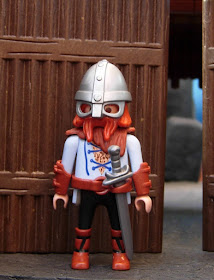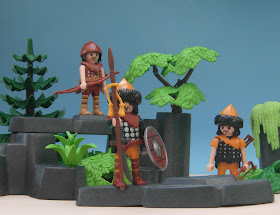LAS RAÍCES VIKINGAS DE PAPÁ NOEL
Por Diego Gómez Sanz
Al acercarse la Navidad y dentro de nuestra afición al mundo
vikingo, volvemos nuestra mirada hacia Papá Noel/Santa Claus. El simpático
personaje gordinflón y risueño, vestido de rojo y blanco y de espesa barba,
embajador de todo lo navideño y repartidor de regalos. No falta en ningún
adorno, tanto en los hogares, como en la calle y la publicidad. Aun compitiendo
con los Reyes Magos, Papá Noel se cuela cada Navidad en nuestras casas como un
emblema más de tan entrañables fiestas. Pero ¿cuál es el origen de este
simpático personaje?
Muchos habrán oído que el origen se encuentra en San Nicolás
de Bari, un obispo que vivió en Asia Menor entre los siglos III-IV d.C. y que
destacó por su bondad y su preocupación por los niños, a los que hacía regalos.
Y es cierto. Pero también se remonta mucho más atrás y en frías regiones del
norte...
Debemos viajar muy al
norte, hasta Laponia. Antes de la llegada del cristianismo, los lapones
practicaban una religión que giraba en torno al reno. Este animal no solo era
su fuerza de trabajo, fuente de energía, alimento y compañero; era también el
emblema de su diosa principal: Beiwe. Los chamanes lapones invocaban a Beiwe
ingiriendo orina de reno y amanita muscaria para comunicarse con la divinidad.
En su trance, aseguraban que los renos volaban. Más tarde se comenzó a hablar
de un personaje que acudía volando en la noche del solsticio de invierno:
Joulupuki (de Joul, "solsticio" y puk, "macho cabrío".
Vestía de rojo y blanco, los colores de la amanita muscaria, y se introducía
por las chimeneas colmando de bendiciones los hogares durante el frío invierno
¿Cuál fue el paso clave para originar este personaje?
La respuesta está en las aportaciones de otro pueblo: los
vikingos. El macho cabrío era símbolo de fertilidad y estaba vinculado con
Thor, el dios de las tormentas. Thor conducía un carro tirado por dos machos
cabríos: Tanngnjóstr (“el que rechina los dientes”) y Tanngrisnir (“el de los
dientes esparcidos”). Durante el solsticio vikingo (el Youl o Yule), las gentes
del norte invocaban a Thor, rogándole que trajera de nuevo el sol para vencer a
las tinieblas. Un personaje que surcaba los cielos acompañado de renos/machos
cabríos: la huella de Thor.
Con el tiempo, un personaje/espíritu que encarna el
solsticio se hace presente en la vida de vikingos y lapones. Una variante de
este Joulupuki fue Hold Nickar, el cual no es sino una variante de Odín, el
dios vikingo más poderoso. El nombre parece venir de su apelativo hjaldr
hnikar: "el que incita a la batalla". Odín, es decir, también un
anciano que surca los cielos, solo que sobre su caballo Sleipnir. En Rusia
comenzó a hablarse de un personaje llamado Abuelo Invierno, con facultades
similares a Odín. Todo ello fue fruto, sin duda, de los intercambios de rusos y
vikingos en la ruta de los grandes ríos.
Cuando los pueblos germánicos y nórdicos fueron
cristianizados, la Iglesia identificó a Joulupuki-Hold Nickar con San Nicolás.
En Holanda su culto se hizo muy popular, conocido por los holandeses como Sinterklaas:
un obispo vestido de rojo y blanco que hace regalos a los niños cada diciembre,
volando por los tejados a lomos de un caballo volador...
La tradición de Sinterklaas fue llevada por los colonos
holandeses a Norteamérica. En Nueva York (fundada por los holandeses como Nueva
Amsterdam) convivían con los colonos ingleses, que no sabían pronunciar bien
aquello de Sinterklaas. Y la cosa derivó en... Santa Claus. Así, desde
principios del siglo XIX, los norteamericanos esperan a Santa Claus cada Navidad.
Fue el dibujante Thomas Nast quien quitó la imagen de obispo medieval al
personaje para devolverle el abrigo nórdico. Así que no señaléis a Coca-Cola:
el origen de Santa Claus es bastante más antiguo...
Y mucho debe a Thor y a Odín ¡Feliz Navidad a todos!
-------------------
Christmas
has come and we are conecting it with the Viking world, we turn our eyes
towards Santa Claus. The nice, plump and smiling character, dressed in red and
white and thick beard, ambassador of all Christmas and gift delivery. There is
no shortage of decorations, both in homes, in the street and in advertising.
Even competing with the Three Wise Men, Santa comes every Christmas to our
homes as an endearing emblem. But what is the origin of this nice character?
Many of you
will have heard that the origin is found in St. Nicholas of Bari, a bishop who
lived in Asia Minor between the centuries III-IV d.C. And who stood out for his
kindness and concern for children, to whom he made gifts. And it is true. But
it also goes back much further back and in cool northern regions ...
We
must travel far north to Lapland. Before the arrival of Christianity, the Lapps
practiced a religion that revolved around the reindeer. This animal was not
only his work force, source of energy, food and companion; Was also the emblem
of its main goddess: Beiwe. The Laman shamans invoked Beiwe by ingesting urine
of reindeer and amanita muscaria to communicate with divinity. In their trance,
they claimed that reindeer flew. Later he began to talk about a character who
flew on the night of the winter solstice: Joulupuki (from Joul,
"solstice" and puk, "goat." He wore red and white, the
colors of Amanita muscaria, and he was introduced by chimneys filling blessings
homes during the cold winter What was the key step to originate this character?
The answer
comes to the contribution of another people: the Vikings. The goat was a symbol
of fertility and it was associated with Thor, the god of storms. Thor was
driving a cart pulled by two goats: Tanngnjóstr ("the one who grinds
teeth") and Tanngrisnir ("the one with the scattered teeth").
During the Viking solstice (the Youl or Yule), they invoked Thor, begging him
to bring the sun back to conquer the darkness. A character that crossed the
skies accompanied by reindeers or goats: the footprint of Thor
Over time,
a character or spirit embodying the solstice is present in the life of Vikings
and Lapps. One variant of this Joulupuki was Hold Nickar, which is but a
variant of Odin, the most powerful Viking god. The name seems to come from his
appellation hjaldr hnikar: "the one that incites to the battle".
Odin, that is to say, also an old man who crosses the skies, only that on his
horse Sleipnir. In Russia began to speak of a personage called Grandpa Winter,
with faculties similar to Odín. This was undoubtedly the result of the exchange
of Russians and Vikings on the route of the great rivers.
When the
Germanic and Nordic peoples were Christianized, the Church identified
Joulupuki-Hold Nickar with St. Nicholas. In Holland his cult became very
popular, known by the Dutch as Sinterklaas: a bishop dressed in red and white
who presents gifts to the children every December, flying through the roofs on
the back of a flying horse ...
The
Sinterklaas tradition was carried by the Dutch settlers to North America. In
New York (founded by the Dutch as New Amsterdam) they lived with the English
settlers, who did not know to pronounce well that of Sinterklaas. And the thing
drifted into ... Santa Claus. Thus, since the beginning of the nineteenth
century, Americans wait for Santa Claus every Christmas. It was the cartoonist
Thomas Nast who removed the image of medieval bishop to the personage to return
the Nordic coat to him. So do not point to Coca-Cola: the origin of Santa Claus
is a lot older ... And a lot owes Thor and Odin... Merry Christmas to all!


















































